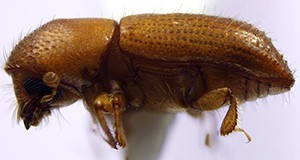Abstract
Xyleborus affinis is one of the most widespread and common ambrosia beetles in the world. It is also very common in Florida. Like other ambrosia beetles, it bores tunnels into the xylem of weakened, cut or injured trees and farms gardens of symbiotic fungus for food. Females lay eggs in the fungus-lined galleries and larvae feed exclusively on the fungi. Recent studies have shown that Xyleborus affinis can vector the fungus responsible for laurel wilt disease, which is lethal to numerous species of trees in the Lauraceae family. This 5-page fact sheet was written by Lanette Sobel, Andrea Lucky, and Jiri Hulcr, and published by the UF Department of Entomology and Nematology, June 2015. (Photo credit: Juri Hulcr, UF/IFAS)
References
Atkinson T. 2014. Bark beetles of North and Central America. http://barkbeetles.info. (1 December 2014).
Bright D E Jr. 1968. Review of the tribe Xyleborini in America north of Mexico (Coleoptera: Scolytidae). The Canadian Entomologist 100: 1288-1321. https://doi.org/10.4039/Ent1001288-12
Carrillo D, Duncan RE, Ploetz JN, Campbell AF, Ploetz RC, Pena JE. 2013. Lateral transfer of a phytopathogenic symbiont among native and exotic ambrosia beetles. Plant Pathology 63: 54-62. https://doi.org/10.1111/ppa.12073
Granda Giro C. 2003. Xyleborus affinis (Eichh) (Coleoptera: Scolytidae) atacando plantaciones de cana de azucar en la provincia de Santiago de Cuba. Fitosanidad 7: 61.
Harrington TC, Aghayeva DN, Fraedrich SW. 2010. New combinations in Raffaelea, Ambrosiella, and Hyalorhinocladiela, and four new species from the redbay ambrosia beetle, Xyleborus glabratus. Mycotaxon 111: 337-361. https://doi.org/10.5248/111.337
Harrington TC, Fraedrich SW. 2010. Quantification of propagules of the laurel wilt fungus and other mycangial fungi from the redbay ambrosia beetle, Xyleborus glabratus. Phytopathology 100: 1118-1123. https://doi.org/10.1094/PHYTO-01-10-0032
Kostovcik M, Bateman C, Kolarik M, Stelinski L, Jordal B, Hulcr J. 2015. The ambrosia symbiosis is specific in some species and promiscuous in others: Evidence from community pyrosequencing. The ISME Journal 9: 126-138. https://doi.org/10.1038/ismej.2014.115
Merkl O, Tusnadi CK. 1992. First introduction of Xyleborus affinis (Coleoptera: Scolytidae), a pest of Dracaena fragrans Massangeana, to Hungary. Folia Entomologica Hungarica 52: 67-72.
Rabaglia RJ, Dole SA, Cognato AL. 2006. Review of American Xyleborina (Coleoptera: Curculionidae: Scolytinae) occurring north of Mexico, with an illustrated key. Annals of the Entomological Society of America 99: 1034-1056. https://doi.org/10.1603/0013-8746(2006)99[1034:ROAXCC]2.0.CO;2
Roeper RA, Treeful LM, O'Brien KM, Foote RA, Bunce MA. 1980. Life history of the ambrosia beetle Xyleborus affinis (Coleoptera: Scolytidae) from in-vitro culture. Great Lakes Entomologist 13: 141-145
Schedl KE. 1962. Scolytidae and Platypodidae Afrikas. Revista de Entomologia de Moçambique, 5: 1-1352.
Steininger MS, Hulcr J, Šigut M, Lucky A. 2015. Simple and efficient trap for bark and ambrosia beetles (Coleoptera: Curculionidae) to facilitate invasive species monitoring and citizen involvement. Journal of Economic Entomology 1-9: DOI: 10.1093/jee/tov014 https://doi.org/10.1093/jee/tov014
Wood SL. 1982. The bark and ambrosia beetles of North and Central America (Coleoptera: Scolytidae), a taxonomic monograph. Memoirs of the Great Basin Naturalist 6: 1-1359.

